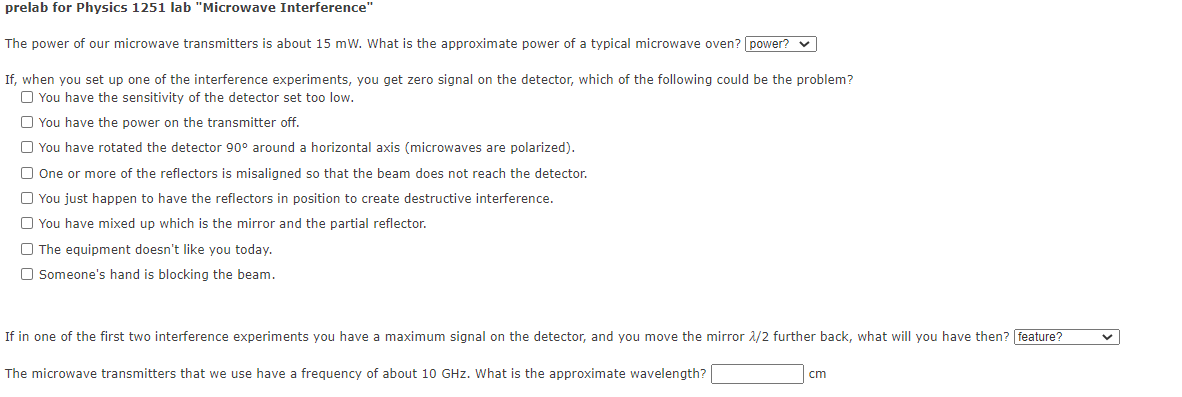The power of our microwave transmitters is about 15 mW. What is the approximate power of a typical microwave oven? power? v If, when you set up one of the interference experiments, you get zero signal on the detector, which of the following could be the problem? O You have the sensitivity of the detector set too low. O You have the power on the transmitter off. O You have rotated the detector 90° around a horizontal axis (microwaves are polarized). O One or more of the reflectors is misaligned so that the beam does not reach the detector. O You just happen to have the reflectors in position to create destructive interference. O You have mixed up which is the mirror and the partial reflector. O The equipment doesn't like you today. O Someone's hand is blocking the beam. If in one of the first two interference experiments you have a maximum signal on the detector, and you move the mirror 2/2 further back, what will you have then? feature? The microwave transmitters that we use have a frequency of about 10 GHz. What is the approximate wavelength? cm
The power of our microwave transmitters is about 15 mW. What is the approximate power of a typical microwave oven? power? v If, when you set up one of the interference experiments, you get zero signal on the detector, which of the following could be the problem? O You have the sensitivity of the detector set too low. O You have the power on the transmitter off. O You have rotated the detector 90° around a horizontal axis (microwaves are polarized). O One or more of the reflectors is misaligned so that the beam does not reach the detector. O You just happen to have the reflectors in position to create destructive interference. O You have mixed up which is the mirror and the partial reflector. O The equipment doesn't like you today. O Someone's hand is blocking the beam. If in one of the first two interference experiments you have a maximum signal on the detector, and you move the mirror 2/2 further back, what will you have then? feature? The microwave transmitters that we use have a frequency of about 10 GHz. What is the approximate wavelength? cm
Related questions
Question

Transcribed Image Text:prelab for Physics 1251 lab "Microwave Interference"
The power of our microwave transmitters is about 15 mW. What is the approximate power of a typical microwave oven? power? v
If, when you set up one of the interference experiments, you get zero signal on the detector, which of the following could be the problem?
O You have the sensitivity of the detector set too low.
O You have the power on the transmitter off.
O You have rotated the detector 90° around a horizontal axis (microwaves are polarized).
O One or more of the reflectors is misaligned so that the beam does not reach the detector.
O You just happen to have the reflectors in position to create destructive interference.
O You have mixed up which is the mirror and the partial reflector.
O The equipment doesn't like you today.
O Someone's hand is blocking the beam.
If in one of the first two interference experiments you have a maximum signal on the detector, and you move the mirror 2/2 further back, what will you have then? feature?
The microwave transmitters that we use have a frequency of about 10 GHz. What is the approximate wavelength?
cm
Expert Solution
This question has been solved!
Explore an expertly crafted, step-by-step solution for a thorough understanding of key concepts.
This is a popular solution!
Trending now
This is a popular solution!
Step by step
Solved in 2 steps
